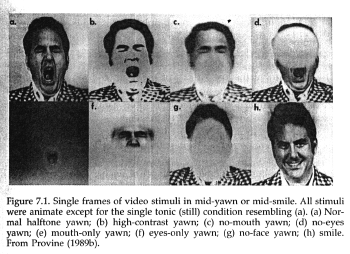The
perception-behavior expressway:automatic effects
of social perception on social behavior
The ability of visually observed yawns to
evoke yawning in wimesses was confumied by the
present rescarch (also sce Provine, 1986).
Observers responded to the overall configuration
of the yawing face independent of its axial
orientation, and no single facial feature, such
as a gaping mouth, served as a sign or releasing
stimulus necessary to evoke yawning. A similar
lack of feature and axial specificity in many
facespecific neurons in the brains of monkeys
suggests a related stimulus analysis. These
results about contagious yawning and
face-specific neurons support those in studies
of prosopagnosia (face nonrecognition) in
brain-damaged humans, and perhaps even the
results of studies of facial imitation in human
neonates, which suggest thâit specud
neural mechanisms detect and p information about
faces. These diverse behavioral and
neurophysiological results may be the product of
a common underlying perceptual process, it seems
unlikely that complex neural mechanisms for
similar visual tasks would evolve indepetently
and have radically different principles of
operation.
Viewing a yawn triggers in us the urge to
yawn, although we have no conscious desire to
imitate the yawner. This extraordinary
neurobehavioral phenomenon has been overlooked
as a scientific problem because it is
commonplace. Yet contagious yawning offers a
useful tool for the exploration of a variety of
phenomena, only some of which directly concern
yawning. For example, the present search for the
releaser of yawning has implications for a topic
of mortegeneral concern, namly, sensory feature
detection. At present, the data for contagious
yawning may be the best evidence for an
expression specific visual-detection process in
humans. The study of contagious yawning is also
a good starting point for the investigation of
contagion, a class of behavior that has been
neglectrd by social psychologists.
The analysis of yawning may also provide
insights into behavioral evolution. For example,
is it fortuitous that the releasing stimulus for
yawning is a view of the act of yawning, or does
the motor act play some active role in the
evolution of the visual mechanism specific for
its detection? We know ordy that yawning is a
phylogenetically ancient behavior performed by
many, if not most, vertebrates. probably as a
homeostatic response to yet unknown
physiological states. Yawning may have evolved
as the cephalic component of a generalized
stretch response that became partially
autonomous. The finding that yawning is most
common in uninteresting situations and shortly
before bedtime and after waking suggests that it
may have an arousing function. The high
frequency of yawning in bored and drowsy people
is probably the basis for yawning as a
paralinguistic signal for these states. However,
the question of an arousing function for yawning
is still open; yawning might be arousing,
dearousing, both, or neither, and the result
might be specific to the situation and/or time
of day. In fact, ont important consequence of
yawning, the opening of the eustachian tubes to
balance middle ear pressure, has nothing to do
with arousal. Yawning, like associated
stretching, is a high-amplitude behavior that
involves many body parts. Identifying one of the
large family of likely physiological correlates
of yawning as its principal function may be
difficult, if not impossible. As with
stretching, yawning may have several functions.
However, the hunt for these functions has been
narrowed by the rejection of one of the most
popular pieces of folklore about yawning: human
yawning is not a response to blood or brain
levels of carbon dioxide or oxygen, and it does
not appear to serve a principal respiratory
function.
The releasing mechanism for contagious
yawning evolved long after the phylogenetically
ancient motor-pattern generator for the yawning
act. Contagious yawning has been demonstrated
with certainly only in humans, in whom it may
have evolved as a means of synchronizing the
behavior of group members. If yawning produces a
physiological transformation in the yawner, then
the chain reaction of contagious yawning
synchronizes the physiological as well as the
behavioral state of the group. Additional
insights about the phylogeny of contagious
yawning are offered by the examination of its
ontogeny. Although the act of yawning may occur
as early as the 11th week alter conception and
is performed by newborns, contagious yawning may
not appear until the second year after brth.
This developmental sequence accords with the
evolutionary scenario described above;
phylogenetically ancient structures and
behaviors are generally considered to develop
before more recently evolved ones. In a passing
comment, Piaget (1951) provided an additional
incentive for studying the development of
contagious yawning; its onset may signal the
emergence of imitation and a change in the
child's relationship with its environment.
However, further incentives for studying
contagious yawning may be unnecessary. Although
the analysis of yawning is in its infancy, its
future looks bright. Contagious yawning has much
to teach us about central issues in behavioral
neuroscience.




